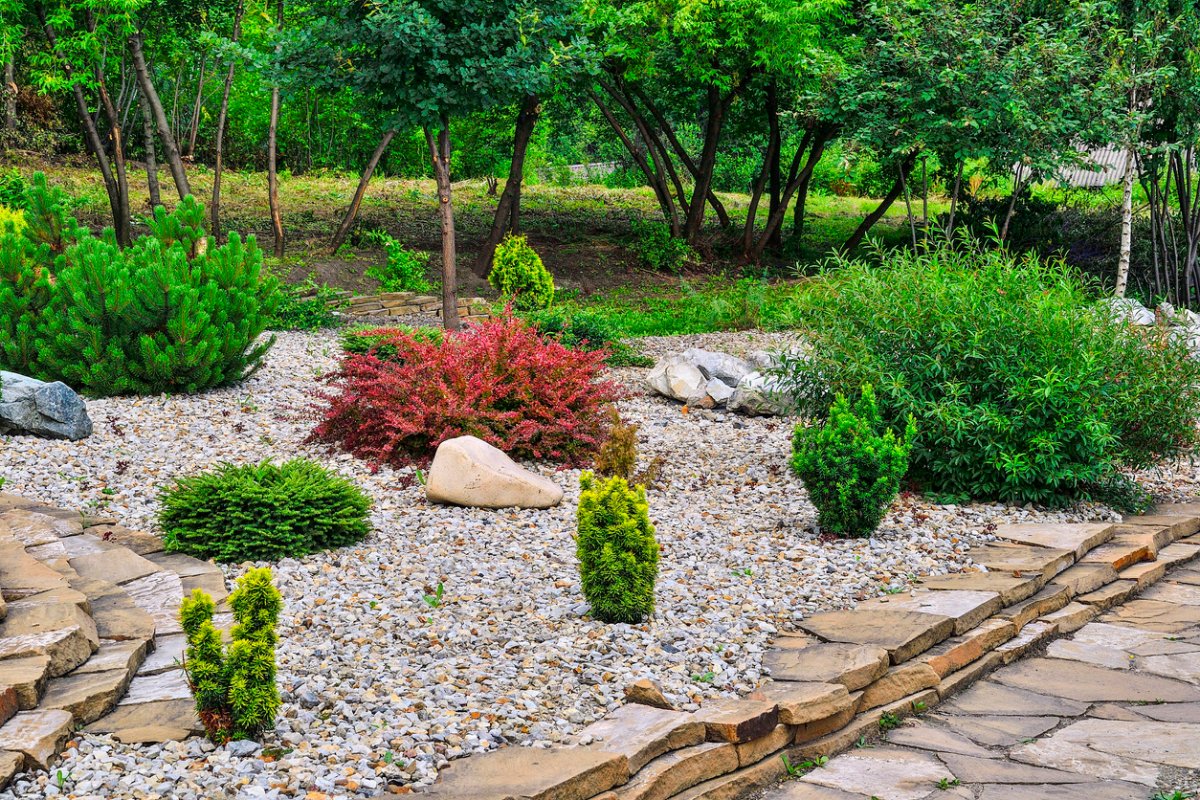We may earn revenue from the products available on this page and participate in affiliate programs. Learn More ›
While landscaping brings greenery to many people’s minds, rocks are an important part of landscaping, too. Perhaps more accurately a hardscaping element, the various types of landscaping rocks add a natural feel to an outdoor scheme.
In addition to adding color, texture, and structure to the yard, landscape rocks can provide a low-maintenance option for walkable surfaces, mulch for planter beds, and a material for features such as fire pits and retaining walls.
RELATED: The Invincible Yard: 25 Ideas for Lazy Landscaping
1. Flagstone
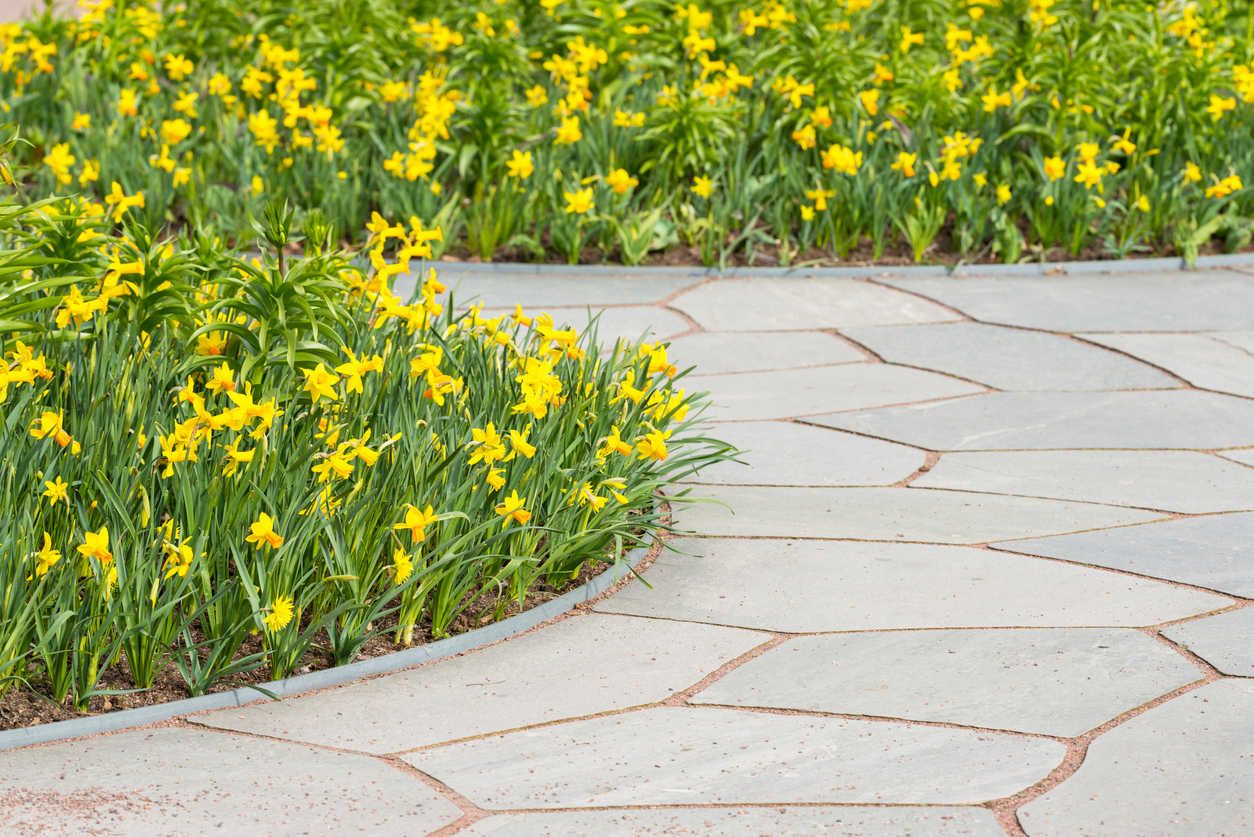
Flagstone makes for quality patio rocks and paths because of its consistent flatness and durability. Since most flagstone slabs are flat and level, they can easily create a safe walkway with little variation in the height of the stones. Comparable in price to concrete pavers, they require additional effort to install, due to their varying shapes, sizes, and thicknesses.
Common types of flagstone include sandstone, slate, bluestone, limestone, and quartzite. Sandstone and limestone tend to be the least expensive of the bunch.
Best For: Walkways and patios
2. Pea Gravel

Pea gravel is often used in driveways, walkways, playgrounds, dog runs, and other high-traffic areas. It’s also a frequent filler around larger stones or for garden mulch. Additional practical uses include incorporating it into projects to improve drainage in wet areas, where water runs off, and even around some types of underground plumbing.
Because it’s permeable, pea gravel is eco-friendly and shouldn’t cause any runoff issues. The small size of pea gravel results in few gaps, which helps minimize weed growth.
Best For: Driveways, pathways, patios, dog runs, and drainage
3. River Rock
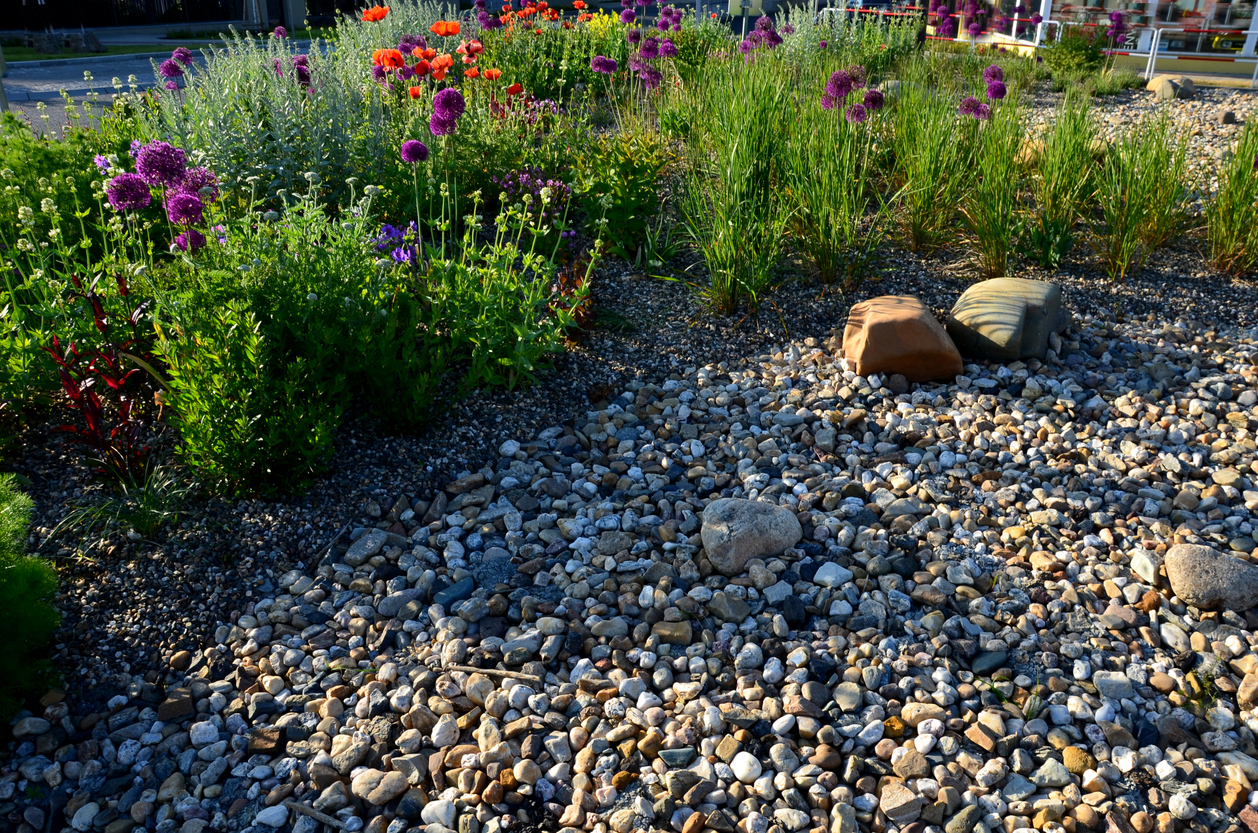
Slightly larger than pea gravel, river rock is a smooth sedimentary, igneous, or metamorphic rock that comes from rivers and creeks. There are roughly dozens of shades of black, gray, brown, and green river rock to choose from, and they’re usually up to 3 inches in diameter. River rock can also feature stripes, striations, or speckles. One unifying trait is that all river rock has been worn down by moving water, so it has a smooth surface.
Like pea gravel, these garden rocks are often used for drainage, for walkways, and for filler between stepping stones. It’s also used in water features and in dry river beds, as well as an alternative to mulch in garden beds.
Best For: Pathways, patios, water features, and drainage
4. Crushed Stone
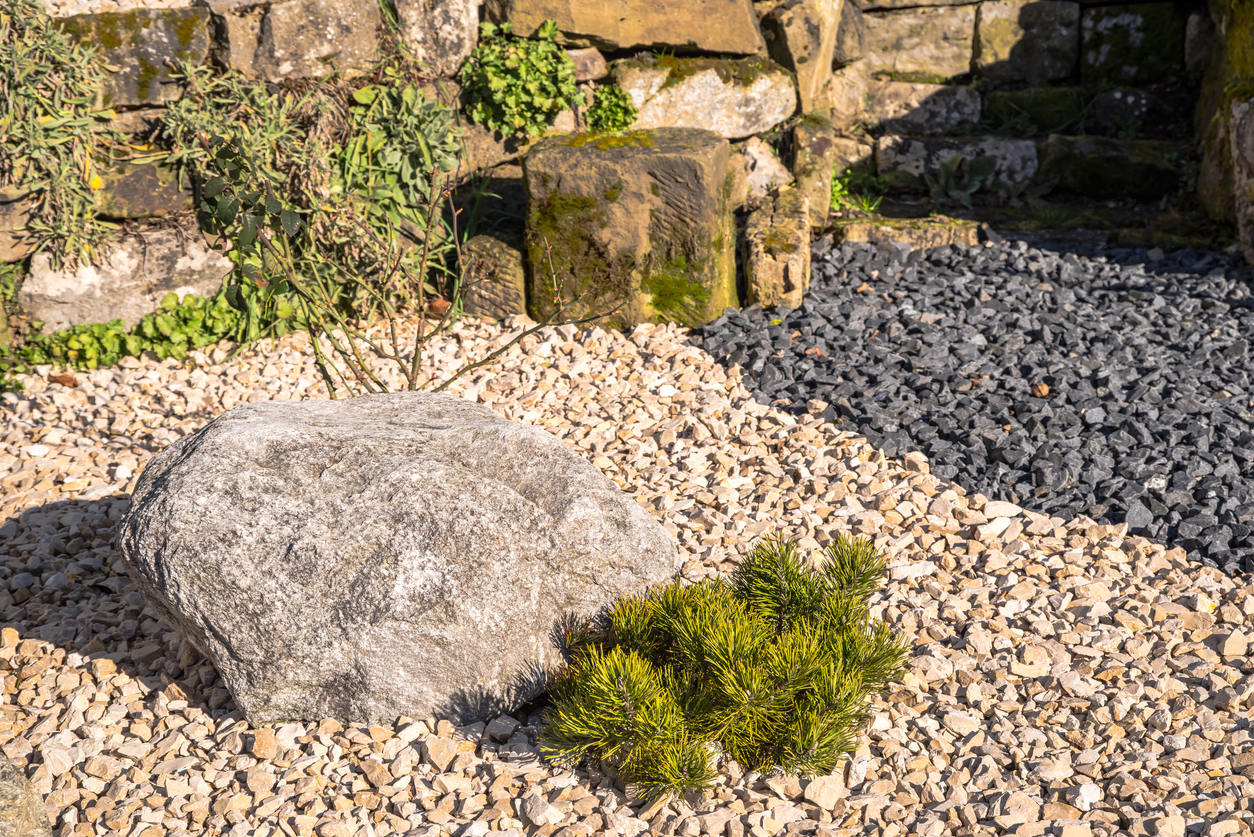
Crushed stone is a low-maintenance choice for mulched beds, walking paths, driveways, and patios, or as an underlayment. While gravel occurs naturally, crushed stone is a byproduct of mining. Common types of crushed stone are limestone and granite, which are passed through a crushing machine to create 1-inch stones with sharp edges. The larger crushed rock is best as an underlayment or as mulch and runoff control where there is no foot traffic.
Smaller crushed rock (also called crusher fine or crusher run) consists of smaller particles mixed with dust that can harden to form a walkable surface. Because it’s inorganic, crushed stone doesn’t decompose like other types of mulch, and because it’s permeable, it enables draining and allows rain to reach plant roots or groundwater. Crushed limestone can add nutrients and reduce the acidity level of the soil. It can also trap heat, an important consideration when placing crushed stone.
Best For: Paths, driveways, mulch, underlayment
5. Boulders

Technically, boulders are stones that are 1 foot or more in diameter, but stones are commonly included in this category if they’re too large for one person to pick up. Beyond that qualification, they can come in a range of sizes, shapes, and colors. Not all boulders are round; they can be flat or angled. In fact, flat boulders make good steps.
These large landscape rocks are sometimes used to build retaining walls or tiered yards because their weight can retain soil. They are also used as focal points or accents in the lawn, under trees, in planting beds, and along driveways and paths, where they add texture and attract the eye.
Because boulders usually have to be delivered and placed with the aid of equipment, the cost of adding these landscaping rocks to your yard can be high.
Best For: Garden accents, rock walls, and terracing
RELATED: 10 Types of Landscaping Rocks Every Homeowner Should Know
6. Fieldstone
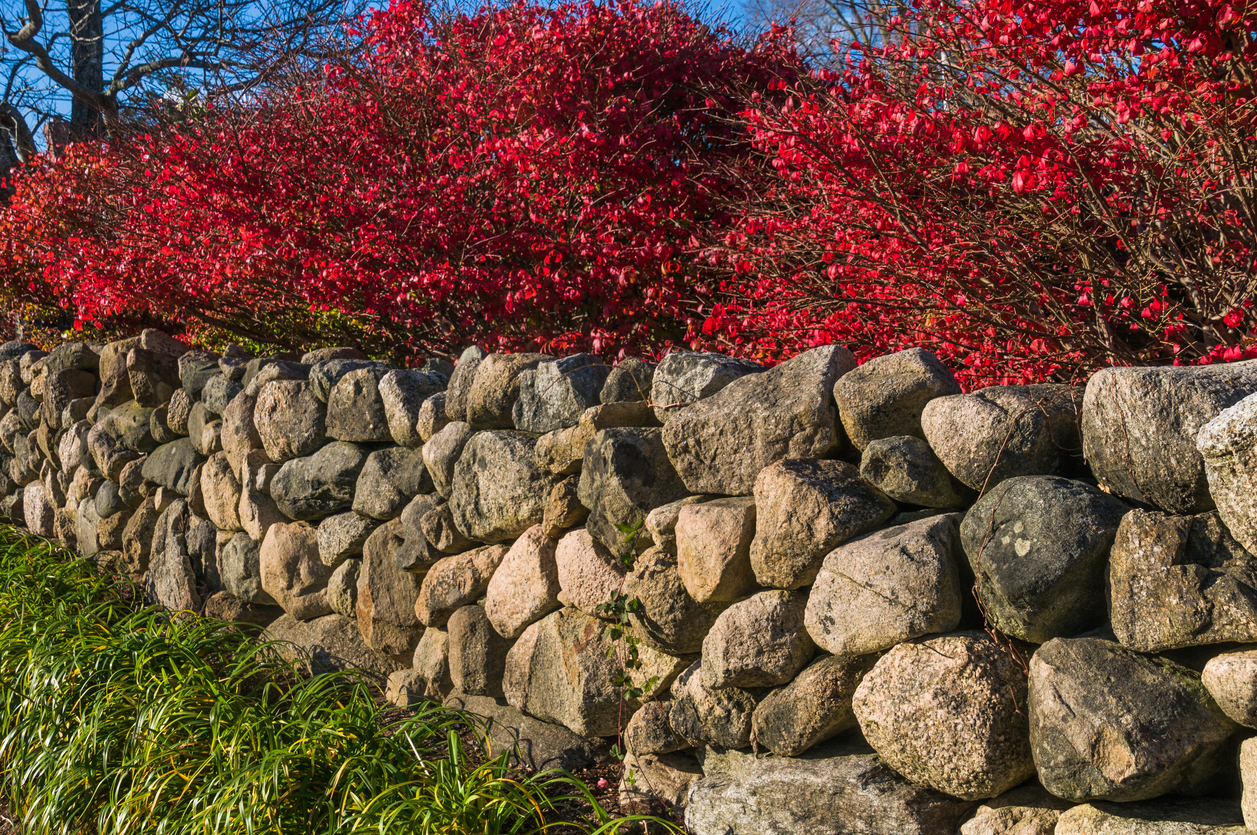
Fieldstone typically consists of large and round stones, and their makeup can consist of different types of rock. In days past, when farmers plowed new fields in rocky regions, they piled up the rocks as they unearthed them. They would then use these stones from the field to build walls. In fact, the stone wall is one of the first uses of stone.
These stone walls may be mortared or simply stacked, depending on the shape of the rocks. Flat field rocks often don’t require mortar, and they can also be used as stepping stones to create garden paths. Large flat fieldstone can serve as seats around a firepit.
Best For: Rock walls, retaining walls, garden paths
7. Lava Rock

Lava rock, or volcanic rock, is made from the molten lava that volcanoes emit. Available in red or black, it tends to weigh less than many other landscaping stones. Thanks to its porosity, lava rock makes them a good choice for drainage areas, but these rocks are more often used as a mulch replacement that doesn’t decompose.
Because lava rocks have a rough texture and irregular shape, they’re typically not suitable for pathways. However, those same characteristics mean they work well in rock gardens, desertscapes, and fire pits. The texture and color of lava rock can be incorporated into rock landscaping ideas with a tropical, island, or desert theme.
Best For: Fire pits, mulch, rock gardens
8. Riprap
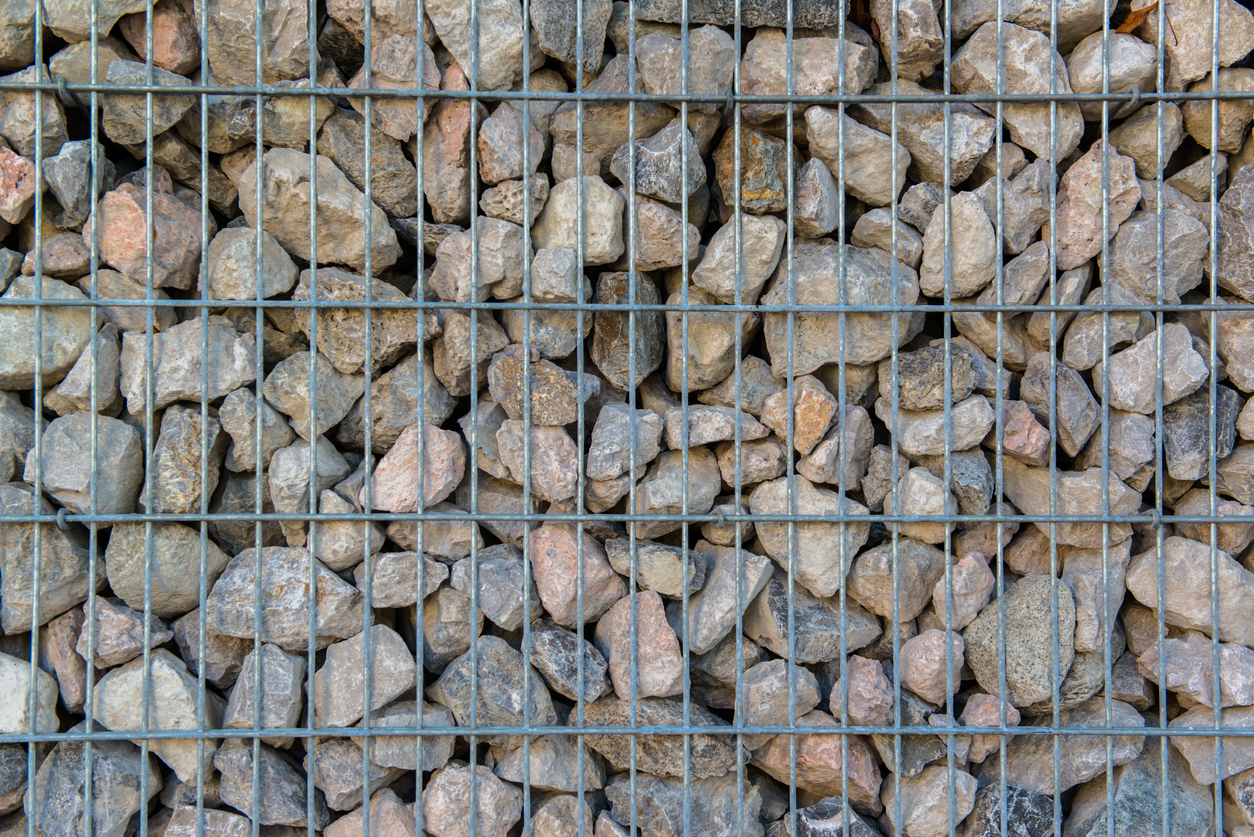
Riprap, aka shot rock, isn’t the most handsome of yard rocks, but it is practical and even necessary for specific sites. Principally used along shorelines, stream banks, spillways, culverts, storm drains, or other waterways to limit erosion, riprap consists of large stones interlocked together. In home landscapes, it can be used in gabion walls, an affordable and effective type of retaining wall.
Rocks typically range from 2 to 24 inches. The diversity in size enhances interlocking. Alternatively, smaller rocks can go into grout or cement applications in which the binder helps hold the aggregate together.
In addition to preventing erosion, riprap walls along the water’s edge can provide a clean look, are easy to maintain, eco-friendly, and long-lasting. However, they don’t work on very steep slopes, can be expensive to repair, won’t prevent flooding, and can inhibit some wildlife from easily accessing either the water or the shore because they are difficult to walk on.
Best For: Waterfront property, ponds, and retaining walls
9. Cobblestone

Made of durable natural stones such as granite, limestone, or basalt, cobblestone is sold in small blocks. Belgian blocks are a popular type of cobblestone because they are fairly uniform, easing the task of installation. They require little maintenance and are easy to repair if needed.
In addition to being one of the most durable surfaces, cobblestone imparts an old-world feel that can add charm and elegance to a driveway, pathway, or patio. It tends to be an expensive choice but conveys an aura of sophistication and history that can add value to a home—while greatly enhancing the look of certain architectural styles, such as English Tudor, French country, and colonial houses.
Best For: Driveways, driveway aprons, walking paths, patios
10. Brick Chips
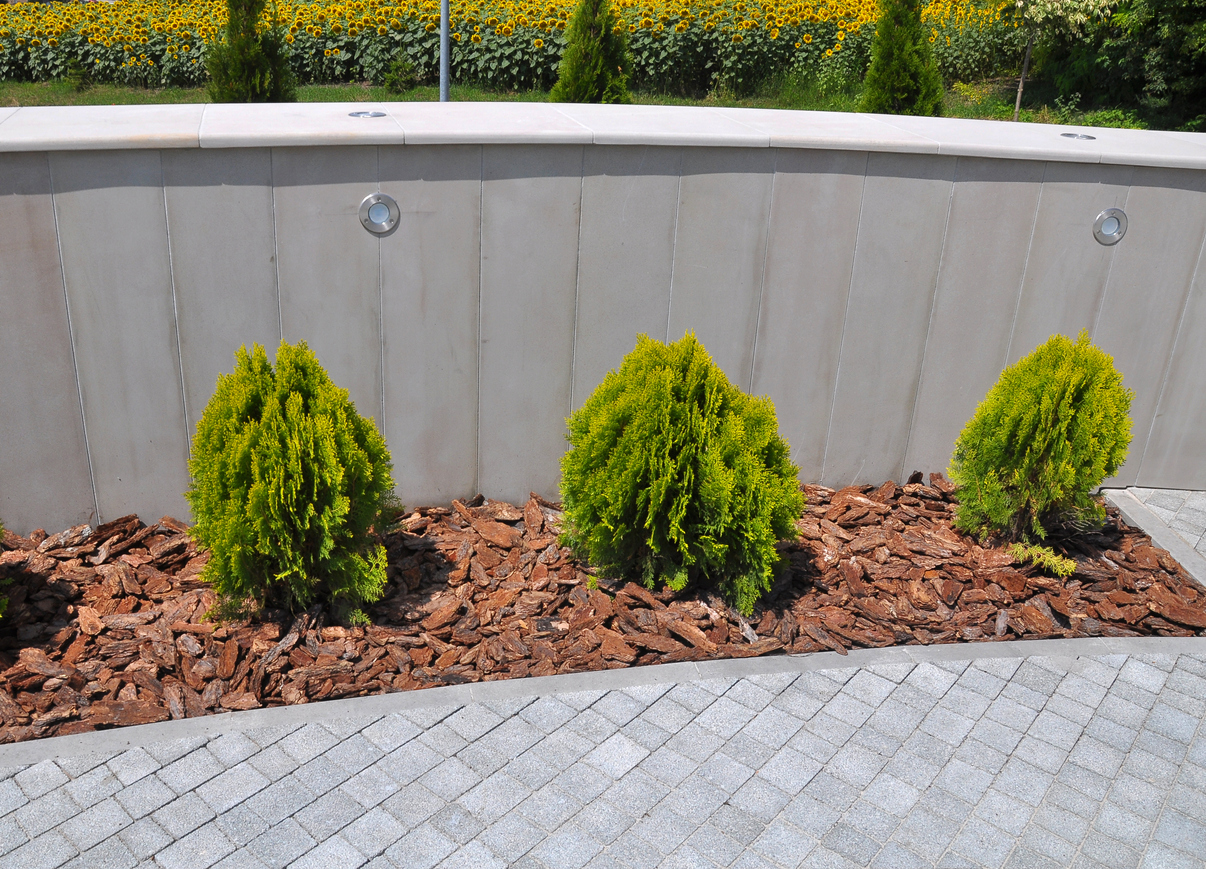
Brick chips are made from bricks that have been crushed and screened. If you’re looking for unique landscaping ideas with rocks, choosing brick chips can be an effective alternative to mulch or ground cover in flower beds. This is because brick chips don’t decay, fade, or attract insects. They also help the soil retain moisture and maintain temperature, both of which promote the growth of healthy plants. Because they’re porous, they allow water to permeate the soil beneath them.
Brick chips are also used for paths and trails, as well as for baseball warning tracks—the wide strip of dirt along the wall or fence that goes around the track.
Best For: Mulch alternative
FAQs
Lava rock and pea gravel are among the most popular types of landscaping rocks, followed by crushed granite, boulders, river rock, gravel, brick chips, marble rocks, and flagstone. However, the popularity and availability of landscape rocks varies by region and use.
Pea gravel is the cheapest landscape rock offered by most retailers, priced at around $4 to $5 for a 40 or 50-pound bag.
The best size of gravel depends on the intended landscaping use and type of rock. To line or mulch a garden bed with smooth gravel, use rocks 1- to 2-inches in diameter. Generally, 10 to 18 mm (about .4 to .7 inch) is the best size for driveways; it doesn’t look too large and won’t easily be displaced by tires. Crusher fines, or decomposed granite, works best for pathways when ¼ inch or smaller.
It depends on the look you want. White rock can brighten dark corners; black lava rock suits a modern or contemporary design. Terra cotta adds warmth and a tropical effect.

